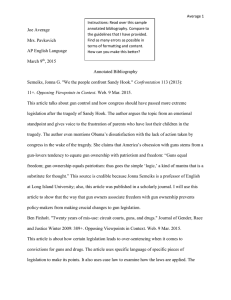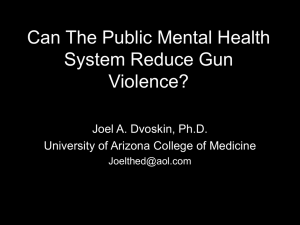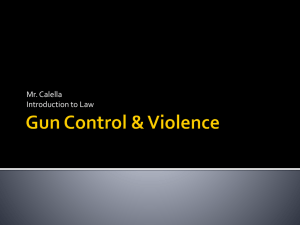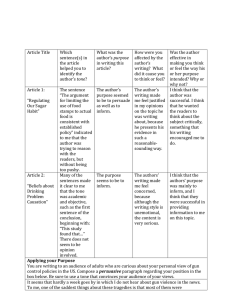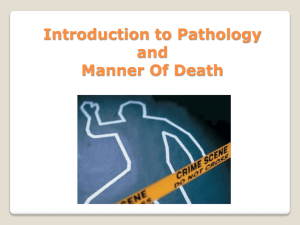Guns of our Fathers - Politics and Government| Illinois State
advertisement
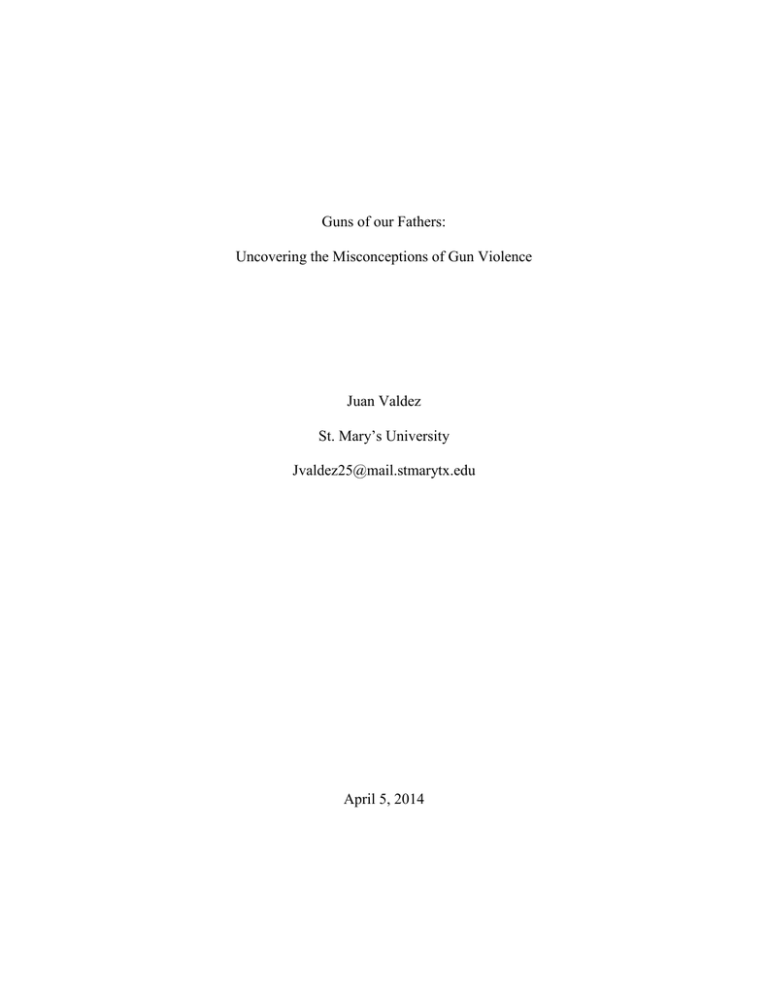
Guns of our Fathers: Uncovering the Misconceptions of Gun Violence Juan Valdez St. Mary’s University Jvaldez25@mail.stmarytx.edu April 5, 2014 Abstract With the Sandy Hook shootings of 2012 and the current gun control debate, several misconceptions about gun control and homicide rates have arisen. The true purpose of the second amendment is explained as many people have questioned the purpose of gun in the 21st century. One of the misconceptions is the belief that imposing stricter gun control laws will significantly reduce the total homicide rate. However, a review of the literature reveals that gun laws are not very effective at explaining a nation’s homicide rate. There is also the possibility of a profit paradox if stricter gun control laws are passed. Utilizing a least ordinary squares multiple regression to examine the individual and collective effects of the independent variables on homicide rates shows that strict gun laws do not impact, nor affect homicide rates. The independent variables are GDP, socioeconomic structure, literacy rate, democratic governance, culture, and types of gun laws in each country. Ultimately, an analysis of the regressions shows that other overlooked factors such as GDP, literacy rates, and socioeconomic inequality impact homicide rates more than gun control. Introduction On the morning of December 14, 2012, five years after the Virginia Tech Massacre, twenty children and six adults were fatally murdered at Sandy Hook Elementary School by an armed assailant by the name of Adam Lanza. The shootings follow recent mass-killings in a shopping mall in Oregon (2012), a movie theater in Colorado (2012), a Sikh temple in Wisconsin (2012), and a business in Minnesota (Kellerman, 2013). The Sandy Hook massacre joined a growing list of gun-related homicides in such varied places as a high school, a college campus, a congressional constituent meeting, a day trader's offices, and a military base. Ultimately, these past few gun incidents have made people question the real purpose of guns in twenty-first century America. This paper analyzes whether or not pursuing gun control measures designed to impose handgun scarcity reduces or affect the total homicide rate. First contextual information is provided for examining this question. Next, a literature review identifies several points of interests to test hypotheses with an international dataset. Ultimately, the question of how gun laws are related to countries homicide rates is examined. Some Background: The Second Amendment In the U.S. Constitution, the Second Amendment states, “A well-regulated militia being necessary to the security of a free state, the right of the people to keep and bear arms shall not be infringed” (U.S. Const. Amend. II). It is clear that the Second Amendment does guarantee the right to bear arms; however, recent scholarship has focused on whether the Second Amendment guarantees an individual [not collective] right to bear arms and whether that right is incorporated against the states (McGovern, 2012, p. 472). In the landmark case of District of Columbia v. Heller, the Supreme Court determined that the Second Amendment guarantees the individual right to possess and carry weapons in case of confrontation and the right to bear arms is not premised upon membership in a state-militia (McGovern, 2012). Moreover, the Court declared that any law banning handguns would be considered unconstitutional and would be immediately invalidated (Softness, 2013). The Supreme Court ruling of District of Columbia v. Heller created an adverse reaction among people such as Duke University professor, Philip J. Cook, who stated, “An increase in gun ownership fuels the secondary market by which guns flow to youths and criminals through loans among family and friends, off-the-books sales and theft” (Jost, 2010). However, the Supreme Court assured that the Constitution still left a variety of tools for combating gun violence, such as longstanding prohibitions on the possession of firearms by felons and mentally ill. In addition, the Court also stated that laws forbidding the carrying of firearms in sensitive places such as school zones, parks, and airports were all still constitutional (Softness, 2013). Criminology Professor Gary Kleck, reiterates the Supreme Court’s ruling by stating, “No one is proposing to legalize the possession or acquisition of guns by convicted criminals, which is currently forbidden in every state” (Jost, 2010). Furthermore, the government is a staunch supporter of laws prohibiting the sale of guns to felons and the mentally ill (Softness, 2013). Why It Matters Many people feel like they have had enough of this gun violence and these deaths (Mantel, 2013); As a result, it is important to understand why the Founding Fathers decided to create the Second Amendment in the first place. The Second Amendment was designed to protect citizens from oppressive governments. The government banning of individual gun ownership is called disarmament and the argument is that disarmament put people at a disadvantage against its own and/or foreign governments. Disarmament, they have argued, would leave the government able to commit democide or- the murder of a person and/or people by a government. This is precisely the reason why gun-rights advocates are strongly against disarmament. Twentieth Century democide involved civilians disarmed either by long-standing gun bans or ones specially adopted to facilitate the killing (Kates 2003). For instance, the Cambodian genocide in 1975 involved soldiers doing house-to-house searches to confiscate any guns that people could potentially use. As a result, and over time, approximately two millionCambodians were slaughtered. Hence, the concept of disarming everyone except the government is completely backwards (Kates, 2003). To prevent a government from ever becoming oppressive, people must acknowledge that they need to legitimately possess small arms to resist illegitimate governments, especially democidal governments (Kopel, 2003). As a final point, the Second Amendment was not solely created to protect people from each other, but also to protect people from something much bigger than them-- something that can ultimately end their freedom. Literature Review The current gun-control debate has been met with misconceptions regarding the national homicide rate. As a result, researchers have often overlooked important factors such as gross domestic product (GDP), literacy rates, and socioeconomic inequality that significantly help explain the national homicide rate. The purpose of this research is to examine whether or not pursuing gun control measures designed to impose handgun scarcity reduce or affect the total homicide rate Pro-gun control advocates believe that banning handguns will lead to a decrease in violence and have a significant decrease in the national homicide rate. For example, Paul Helmke, President of the Brady Campaign to Prevent Gun Violence, states, “Adding more guns to a home, a state or a country leads to more gun violence, not less” (Jost, 2007). Moreover, in1968, Zimring indicated, “the effect of firearm elimination would itself be quite substantial [in decreasing homicide rates]” (1968, p. 737). It is plausible to believe that eliminating firearms would significantly decrease the homicide rate, as stated by Helmke and Zimring, but the elimination of firearms could also produce other unintended consequences, such as creating a profit paradox. A profit paradox occurs when a government tries to ban a product that is in high demand and, as a consequence, the demand and profitability of the banned product skyrockets in the black market. Thus, the product becomes more available through the black market. For instance, the United States has a strict drug-enforcement strategy, but it is because of this strategy that the profitability and the demand for drugs are so high (Bertram, 1996). Mexico has grown to be the number one supplier of marijuana to the United States and the four major drug cartels have garnered billions of dollars from drug trafficking (Katel 2008). Currently, gun traffickers operate freely around the globe because little information is available about their activities, and governments have frequently been unwilling to act on the information they have collected (Goldring, 2002). Similarly, cracking down on firearm smugglers is not an easy task since firearm and drug smugglers have not only created a black market, but according to Stohl (2005), they have created an underground economy that consists of a set of interrelated black markets supported by their own systems of information, their own sources of supply, their own distribution networks, and their own modes of financing. This “underground economy” not only allows easy access to cartels, but just about anyone wishing to get their hands on drugs and Figure 1. Homicides 2007 to 2011 Firearm Homicides Homicides 5.7 5.4 5 4.8 4.7 68% 67% 67% 67% 68% 2007 2008 2009 2010 2011 -firearms; hence, banning handguns will not necessarily reduce the availability of them. As a result, simply eliminating firearms may not be the best route to reduce the homicide rate Homicides While pro-gun control advocates believe that eliminating handguns will decrease the homicide rate, others argue that “pursuing any gun control measure designed to impose handgun scarcity on the general population is both needless and useless” (Stell, 2004, p. 39). In 1968, for example, Zimring found that America’s homicide rate depended on the percentage of homicides committed with guns. Stell (2004), however, illustrated that America’s homicide rate fluctuated over the course of a century- from a low of 1.1 per 100,000 in 1903 to a high of 10.7 in 1980. Stell (2004) asserted “Unlike the nation’s homicide rate, a random sampling indicates that the percentage of homicides committed with firearms has remained comparatively the same [6070%]” (p. 40) over the time examined. To affirm Stell’s assertion, recent homicide rates and the percentage of homicides committed with firearms were examined. The data were replicated (see Figure 1) the trend was similar to Stell’s finding-- homicide rates fluctuate over time while the percentage of homicides committed with firearms remained constant. For example, the total homicide rate decreased from 5.7 homicides per 100,000 population in 2007 to 4.7 homicides per 100,000 population in 2011. Yet the percentage of homicides committed with firearms remained constant (67%-68%) from 2007-2011. As a result, Stell (2004) demonstrated that America’s homicide rate is virtually independent of the percentage of homicides committed with guns. The Misconceptions Many people assume that the United States has the highest homicide rates because guns are easily obtainable (Kates and Mauser, 2007, p.649). On the contrary, a review of the literature says otherwise. For instance, Kates and Mauser (2007) examined the Russian homicide rate and found that in between the years of 1998-2004, Russian murder rates were about four times higher than the United States and similar rates characterize former Union of Soviet Socialist Republics nations. It is important to note that in the early 1970’s the Soviet Union was a generally gun-less country compared to the U.S. Kates and Mauser argue that other weapons are substituted in killings when guns are scarce (p. 649). Another misconception identified in the literature is the relationship between homicide rates and strict gun control. Kates and Mauser (2007), for example, examine this relationship in Europe and found increases in the amount of gun-related crimes. The authors assert that even after handguns were banned in the United Kingdom the use of guns in serious crime increased a hundredfold (p. 655). Moreover, the authors also cite two studies from 2004 by the U.S. National Academy of Sciences,-which reviewed 253 journal articles, 99 books, 43 government publications, and some original empirical research and “failed to identify any gun control that had reduced violent crime, suicide, or gun accidents” (p. 654). Finally, Stell (2004) asserts that banning handguns will not make them scarce, but make them more readily available like other banned substances such as crack, cocaine, and marijuana (p. 45). Overlooked Data Several gun-violence analysts have often overlooked and avoided the “socioeconomic predicament and cultural norms of communities with disproportionately high rates of violence” and there cannot be a “satisfactory explanation of lethal violence” without them (Jacobs, 2002, p. 11). Furthermore, in trying to explain the variation between violence rates and gun control laws across different countries, Miron (2001) states that culture, history, and social norms makes attitudes toward both violence and gun control substantially different across countries. Dixon and Lizotte (1987) assert that violent crime rates in southern United States, for example, are not a result from poverty or a violent subculture, but because of “relative deprivations related to ascriptive socioeconomic inequalities in that region” (p. 386). Ultimately, what current gunviolence analysts fail to include in their research are the differences and inequalities in the socioeconomic region they are studying. Predicting Homicides A review of the literature reveals that gun laws are not very effective at predicting a nation’s homicide rate. Instead, Boix (2008) states, “Violence intensifies in unequal economies in which most wealth is fixed.” (p. 392). As a consequence of economic inequality, desperate people in the lower economic classes may resort on other methods to supplement their household income, such as joining gangs, smuggling drugs, and undertaking violent activities. In fact, Collier and Hoeffler (2002) have stated that the supply of rebels increases if the economic opportunity cost of rebellion is low. Sambanis (2004) also linked poverty to violence from the results of a comparative case study project that included twenty-one countries and more than thirty civil wars. The results showed that violence was most prevalent in countries with a low or declining GDP. Unlike gun laws, literacy rates are also effective for predicting a nation’s homicide rate. A low literacy rate in a country blocks people from better employment opportunities; therefore, nations with low literacy rates have higher homicide rates because there is a low opportunity cost in committing violence to achieve a higher social status (Chon 2011). By studying homicides in Latin America, Chon (2011) concluded that economic inequality, poverty, and low literacy rates were significant factors that contributed to Latin America’s high homicide rates. A review of the literature has yielded mixed results. Most literature suggests that banning firearms does not reduce the total homicide rate committed with firearms. On the contrary, banning firearms makes firearms more available through the illicit market; consequently, creating other forms of crime and violence. However, other literature suggests that a country’s Gross Domestic Product (GDP) and literacy also serve as good predictors of the total homicide rate. Moreover, homicides can also be traced back to the socioeconomic inequality of a country—an aspect in the literature that is often overlooked and neglected. Given this literature, this paper examines four hypotheses: - H1: Countries with a low or declining GDP will have higher homicide rates by guns than countries with higher GDP H2: Countries with low literacy rates will have higher homicides by guns than countries with higher literacy rates. H3: Countries with high socioeconomic inequality will have higher homicides rates by guns than countries with lower socioeconomic inequality. H4: The severity or strictness of a country’s gun laws will have little to no effect on the homicide rate of a country. Methodology The unit of analysis for this research is countries. Two dependent variables are examined—a country’s homicide rate and a country’s homicide rate by guns. These two dependent variables provide a test of the association of a country’s severity of gun laws while controlling for other independent variables. The national homicide rate and gun homicide rates and are measured by the number of intentional homicides per 100,000 people. The homicide rate caused by firearms is measured by the percentage of homicides caused by guns—expressed per 100,000 people. The independent variables are GDP, socioeconomic structure, literacy rate, democratic governance, culture, and types of gun laws in each country (see Table 1). The GDP is measured by the sum of gross value added by all resident producers in+ the economy plus any product taxes and minus any subsidies not included in the value of the products, expressed in international dollars using purchasing power parity rates and divided by total population during the same period. The socioeconomic structure is measured by the human development index (HDI) on inequality in distribution of years of schooling based on data from household surveys and the loss in income due to inequality. The loss is the difference between two averages – the arithmetic mean which does not account for inequality and the geometric mean which does. The loss, expressed as a percentage, is the relative difference between the two. The literacy rate is measured by the percentage of the population ages 15 and older who can, with understanding, both read and write a short simple statement on their everyday life. The types of gun laws/policies in each country is measured by their strength on a scale of 0 to 11, 0 being no gun restrictions and 11being the strictest type gun of laws. Independent Variable Gross Domestic Product (GDP) Socioeconomic structure Inequality in Education (Inq. Ed.) Income Loss% Literacy rate Adult Literacy Rate (ALR) Gun Law Strength TABLE 1: List of Independent Variables Definition Source Sum of gross value added by all resident producers in the economy expressed in international dollars using purchasing power parity rates and divided by total population during the same period. Inequality in distribution of years of schooling based on data from household surveys, and the loss in income due to inequality. Percentage of the population ages 15 and older who can, with understanding, both read and write a short simple statement on their everyday life. The types of gun laws/policies in each country is measured by their strength on a scale of 0 to 11, 0 being no gun restriction and 11 being the strictest type gun laws. Additive index Human Development Report, published annually by the United Nations Development Program. Human Development Report, published annually by the United Nations Development Program. Human Development Report, published annually by the United Nations Development Program. Retrieved from http://www.gunpolicy.org/ This paper utilizes descriptive and inferential (univariate and multivariate) statistics, principally least ordinary squares multiple regression to examine the individual and collective effects of the independent variables on homicide rates to test the hypotheses. Analysis To examine for issues of multicollinearity, a correlation analysis was conducted with all the variables of interest. A correlation of the independent variables showed that Gross Domestic Product (GDP), Income Loss, Inequality in Education (Inq. Ed), and Adult Literacy Rate (ALR) TABLE 2: CORRELATIONS HOM (per 100k) GDP (PPP$) Income Loss(%) GunHomicide Inq. Ed. Strength of gun law in country ALR(%) Strength of Income GunHomic gun law in Loss (%) ide country ** ** .493 .909 .024 HOM (per 100k) 1 GDP (PPP$) -.326** -.326** .493** 1 -.434** -.434** 1 -.222* .540** .052 -.124 .909** -.351** .024 -.222* .760** .052 .540** -.448** -.124 1 -.285** -.027 -.027 .285** 1 -.201* .468** -.104 -.058 .051 ** Correlation is significant at the 0.01 level (2-tailed). * Correlation is significant at the 0.05 level (2-tailed). - were statistically significant when correlated with Homicides per 100k (HOM).The same variables, except for adult literacy rate, were also statistically significant when correlated with Gun Homicides. Moreover, the strength of gun law in country failed to be statistically significant with both dependent variables. Finally, to avoid issues associated with multicollinearity, inequality in education was removed from the regression because of its strong association with GDP (.760). By using a multiple regression to examine the individual and collective effects of the independent variables on homicide rates, four regression equations were examined—Model A homicide; Model B homicide without adult literacy rate; Model C gun homicide; and Model D Latin America. Table 3 reports the comparative results of the four models (below). Here, for example, Model A shows that strength of gun law is not statistically significant when explaining the homicide rate. The only statistically significant (prob.=.000) variable in this regression was Income Loss with a coefficient (standardized beta) of .44. In all, model A explains 22% of the variance of homicides per 100k (F-test= 7.63). To increase the R square, ALR was dropped in model B. This variable was the least correlated with HOM per 100k and not statistically significant in the previous regression. By dropping ALR in model B, GDP became statistically significant along with income loss and the R square increased to 29% while the F test increased to 16.54. Here, as GDP decreased, the number of homicides increased. The beta coefficient for income loss was the strongest and increased from .435 to .453. The relative importance of Income Loss and GDP can be found by squaring their betas of .453 and -.194 respectively, and dividing them which equals to a ratio of 5.40 (.453 squared = .205, -.194 squared = .038, .205/.038 = 5.40). Therefore, Income Loss carries over five times the explanatory power in explaining homicides per 100k population than GDP does. Strength of gun law also failed to be statistically significant when examining model C for Homicides by Guns (GunHomicide per 100k. Again, Income Loss, with a beta of .559 is the only variable that is statistically significant (prob.=.000). In addition, the R square is .281 while the F test equals 11.02. Taking a closer look at the frequency distribution of gun homicides reveals that about 70% of the countries in the world have homicides less than or equal to 5 per 100,000 population (mean=5 per 100,000). The countries with the highest homicide rates are those in Latin America, which have homicides way above 10 per 100,000 population. As seen in the appendix (Table 4), Latin American countries (dichotomized) were highly correlated with gun homicides. As a result, a fourth and final regression (Model D) was created, which added Latin American countries as a dummy variable along with GDP, Income Loss%, and strength of gunTABLE 3: REGRESSION MODELS OF INTERNATIONAL HOMICIDES AND GUN HOMICIDES A B C D Standardized Standardized Standardized Standardized Betas Betas Betas Betas (error ) (error ) (error ) (error ) -.124 -.194* .009 -.028 GDP (PPP$) (.000) (.000) (.000) (.000) .436** .453** .559** .100 Income (.141) (.123) (.128) (.158) Loss(%) -.081 ALR(%) (.104) .090 .088 -.008 .022 Strength of (.642) (.507) (.524) (.460) gun law in country .605** Latin (3.343) American Countries 16.60 7.63 16.54 11.02 F Sig. Adj R2 .000 .22 .000 .29 .000 .281 .000 .448 ** significant at the 0.01 level (2-tailed). * significant at the 0.05 level (2-tailed). -law. The results were astonishing. Here, the Latin American countries variable (33 countries) is the only statistically significant variable while GDP, Income Loss%, and strength of gun law failed to be statistically significant. Model D explained 45% of the variance in gun homicides, and had an F test of 16.6. Conclusion The Sandy Hook incident indeed brought a lot of pain to people and fueled the campaign to impose stricter gun laws on the general public. Conversely, the literature suggests that gun laws do not affect homicide rates. In accordance with the literature review, the results of the analysis show that gun law strength does not affect homicides, nor homicides committed with firearms. While GDP was only statistically significant in model B, it illustrates how the economic development of a country can affect its homicide rates. Low economic development is related to high homicide rates. Interestingly, in models B and C, Income Loss(%) was the strongest and most significant variable out of the three models (A, B, and C), signaling the importance of reducing the income loss percentage in a country as opposed to imposing stricter gun laws to prevent homicides. Nonetheless, the variable strength of gun law is still not statistically significant; thus, accepting the null hypothesis for strength of gun law and rejecting the null hypothesis for GDP and the socioeconomic structure for model B. The relationship of Income Loss% was negative in models B and C, suggesting that reducing the income loss% in a country may lead to a greater reduction of homicides and homicides committed with firearms. Because strength of gun law and GDP failed to be statistically significant, the null hypothesis was accepted for both variables, and rejected for Income Loss in model C. Ultimately, GDP, income loss, and gun law strength failed to explain the high homicides committed with firearms in Latin American countries; thus, leaving my research open for continuation. The limitation of this study is the emphasis of current research. Current research is seemingly over focused on how guns affect a country’s homicide rate, instead of focusing on why there is such a high homicide rate in the first place. Economic factors, the analysis revealed, are the primary cause of homicides in countries, yet this area of research is often overlooked and neglected. Finally, in all four models (A, B, C, and D1), strength of gun law failed to be statistically significant, confirming the hypothesis of the paper that gun laws do not impact homicide rates, nor homicides committed with firearms. 1 33 Latin American Countries References Bertram, E. (1996). Drug war politics: The price of denial. Berkeley: University of California, p. 15. Retrieved from Google Books. Boix, C.(2008). Economic roots of civil wars and revolutions in the contemporary world. World Politics 60(3), 390-437. Cambridge University Press. Retrieved from Project MUSE. Chon, D. (2011). Contributing factors for high homicide rate in Latin America: A critical test of Neapolitan's regional subculture of violence thesis. Journal Of Family Violence, 26(4), 299-307. doi:10.1007/s10896-011-9365-5 Collier, P., & Hoeffler, A. (2002). Greed and grievance in civil war. World Bank, Retrieved from http://economics.ouls.ox.ac.uk/12055/1/2002-.pdf Dixon, J. & Lizotte, A.J. (1987). Gun ownership and the southern subculture of violence. American Journal of Sociology 93.2: 383. Retrieved from JSTOR FBI. (n.d.). Federal Bureau of Investigation. Retrieved from http://www.fbi.gov Goldring, N. J.(2002). Creating a gobal transparency regime. SAIS Review 22(1), 207211. Retrieved from Project MUSE. Jacobs, J. B. (2002). Can gun control work? Oxford: Oxford UP. 11. Retrieved from Google Books Jost, K. (2010). Gun rights debates. CQ Researcher, 18, 889-912. Retrieved from CQ Researcher (2007). Gun violence. CQ Researcher, 17, 457-480. Retrieved from CQ Researcher Katel, P. (2008). Mexico's drug war. CQ Researcher, 18. Retrieved from http://library.cqpress.com/cqresearcher/ Kates, D. B.(2003). Democide and disarmament. SAIS Review. 23(1), 305-309. Retrieved from Project MUSE Kates, D. B., & Mauser, G. (2007). Would banning firearms reduce murder and suicide?. Harvard Journal Of Law & Public Policy, 30(2), 649-694. Retrieved from Academic Search Complete Kellermann, A. L., & Rivara, F. P. (2013). Silencing the science on gun research. JAMA: Journal Of The American Medical Association, 309(6), 549-550. Retrieved from Academic Search Complete Kopel, D. B.(2003). The UN small arms conference. SAIS Review 23(1), 319-322. Retrieved from Project MUSE Mantel, B. (2013). Gun control. CQ Researcher, 23, 233-256. Retrieved from CQ Researcher McGovern, O. (2012). The responsible gun ownership ordinance and novel textual questions about the second amendment. Journal Of Criminal Law & Criminology, 102(2), 471-496. Retrieved from Academic Search Complete Miron, J.A.(2001) Violence, guns, and drugs: A cross‐country analysis. The Journal of Law and Economics 44.S2: 615-33. Retrieved from JSTOR. Softness, B. S. (2013). Preserving judicial supremacy come Heller high water. University Of Pennsylvania Law Review, 161(2), 623-652. Retrieved from Academic Search Complete Sambanis, N. (2004). Poverty and the organization of political violence. Brookings Trade Forums, 165-211. Retrieved from the Project Muse database. Stell, L. K. (2004). The production of criminal violence in America: Is strict gun control the solution. Journal Of Law, Medicine & Ethics, 32(1), 38-46. Retrieved from Academic Search Complete Stohl, R. (2005). Fighting the illicit trafficking of small arms. SAIS Review,25, 59-68. Retrieved from Project Muse. Zimring, F. (1968). Is gun control likely to reduce violent killings? The University of Chicago Law Review 35 (4): 721–737. doi:10.2307/1598883.

